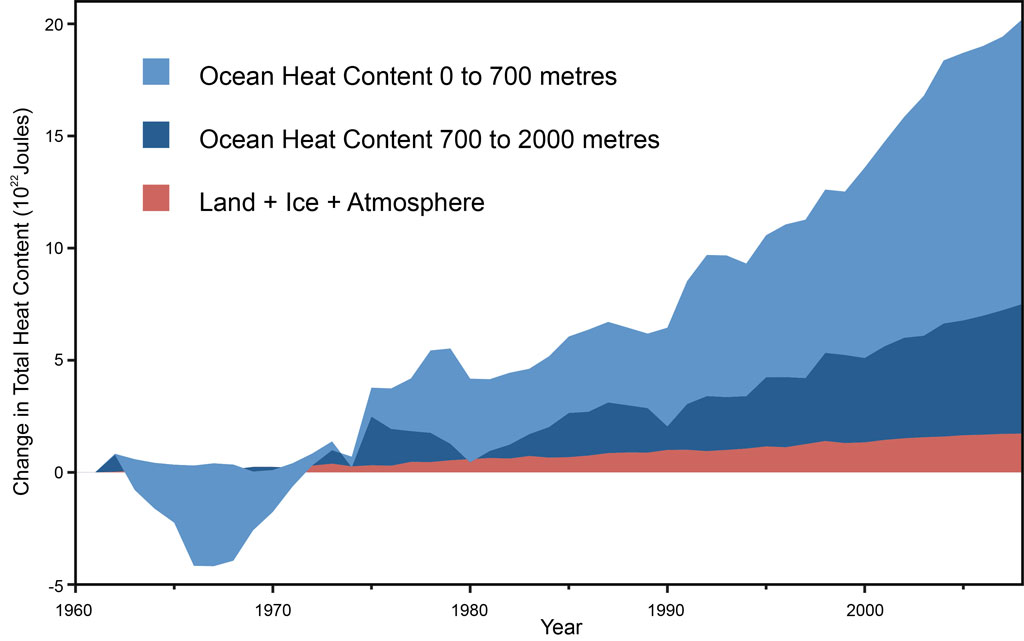
As we have previously discussed, the overall warming or heat accumulation of the planet has continued, and if anything accelerated over the past 10–15 years (Figure 1).
Figure 1: Land, atmosphere, and ice heating (red), 0-700 meter OHC increase (light blue), 700-2,000 meter OHC increase (dark blue). From Nuccitelli et al. (2012).
However, over the past week or two there has been a spate of articles from the New York Times, Washington Post, The New Republic, and Der Spiegel, all of which get many details right (including noting the warming of the oceans), but that all begin from the premise that “global warming” has slowed.
It would be more accurate to say that global surface air warming has slowed, but the overall warming of the Earth’s climate has sped up. Only about 2% of the planet’s overall warming heats the atmosphere, so if we focus only on surface air temperatures, we miss 98% of the overall warming of the globe.
Figure 2: A visual depiction of how much global warming heat is going into the various components of the climate system for the period 1993 to 2003, calculated from IPCC AR4 5.2.2.3. Note that focusing on surface air temperatures misses more than 90% of the overall warming of the planet.
About 90% of the warming of the planet is absorbed in heating the oceans. However, until the past few years, our measurements of ocean temperatures (especially of the deep oceans) were somewhat lacking. Our measurements of surface air temperatures were much more accurate, and so when people spoke of “global warming,” they tended to focus on air temperatures.
In the 1980s and 1990s when air temperatures were warming in step with the overall warming of the planet, that was fine. However, over the past decade, the warming of surface air temperatures has slowed. At the same time, the overall warming of the planet has continued, and if anything it has accelerated. This has been difficult to reconcile for those who previously focused on surface air temperatures – what do we say about “global warming” now?
The result has been the series of articles linked above, which begin from the premise that global warming has "stalled." However, given that the overall warming or heating of the planet continues at a rate equivalent to 4 Hiroshima atomic bomb detonations per second, this framing of the issue is clearly inaccurate and misleading. The articles did subsequently discuss ocean warming, but the initial framing of the supposed 'global warming pause' is bound to confuse readers.
Research on the causes of slowed surface air warming is of course ongoing. The question remains how much other factors have contributed to the surface warming slowdown. For example, aerosols and low solar activity over the past decade likely played a role as well. However, Watanabe et al. (2013) suggests that these factors can’t explain most of the slowed surface warming, which his study attributes to a more efficient transfer of heat to the deep oceans. This result is consistent with the 'hiatus decades' found in Meehl et al. (2011) and (2013).
These studies in combination with Guemas et al. (2013) and Balmaseda et al. (2013) suggest that the more efficient ocean heat uptake is a temporary effect that will sooner or later reverse and lead to accelerated surface warming. Meehl et al. (2013) suggests this will occur when the Interdecadal Pacific Oscillation (IPO) next switches to its positive phase.
The bottom line is that the body of scientific research suggests that the current slowed surface warming is mainly due to natural oceanic cycles, and thus is only a temporary effect. However, a political blog for the Economist suggested that we should take a 'wait and see' approach for 'a decade or two'.
The argument is based on both the surface warming 'pause' and the premise of low climate sensitivity. However, research has remained consistent with the IPCC range of 2–4.5°C equilibrium warming in response to a doubling of atmospheric CO2. Some recent research has suggested the value might be toward the low end, but other recent research has suggested otherwise. In any case, even in a realistic best case scenario, we're not doing enough to decarbonize the economy if we want to avoid dangerous and potentially catastrophic global warming.
Taking a ‘wait and see’ approach for another decade or two would be a recipe for certain disaster. Fortunately that blog recommendation is at odds with the approach suggested by The Economist’s correspondents, who agree that in any case we’re not doing nearly enough to decarbonize the economy if we want to avoid dangerous climate change.
The key take-home point is that we now have better measurements of ocean and global heat accumulation. We no longer have to settle for focusing on the 2% of global warming represented by surface air temperatures. Consider the analogy offered by Greg Laden, that the planet is a dog and surface temperatures are his tail. In the past we only had a GPS locator on his tail. It wags around a lot, sometimes accurately representing the movement of the dog, sometimes not. Now we’ve got a second GPS locator on his body – should we continue focusing on the movement of the tail for old times’ sake, or should we shift our focus to the more representative measurements?
Ideally people will begin using the term “global warming” to refer to the planet’s overall heat accumulation. Or use the term “global heating” or “climate change” or “global disruption.” Whatever term is chosen, we need to stop misleading people by saying that global warming has “paused.” The overall warming of the planet has not and will not pause until we stop increasing the greenhouse effect through our reliance on fossil fuels. The warming will only continue to grow.
Posted by dana1981 on Tuesday, 25 June, 2013
 |
The Skeptical Science website by Skeptical Science is licensed under a Creative Commons Attribution 3.0 Unported License. |